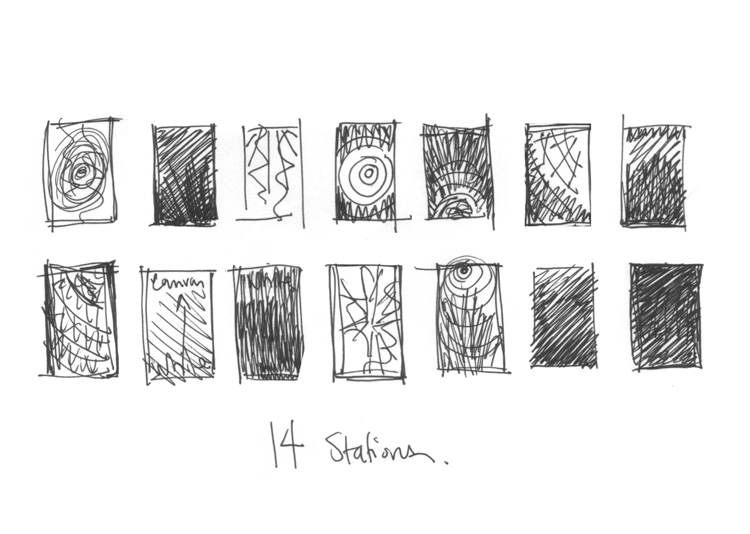"The goal of painting is to create a habitable illusion for the subject of painting.” -Frank Stella
“Mankind, which in Homer’s time was the object of contemplation for the Olympian gods, now is one for itself. Its self-alienation has reached such a degree that it can experience its own destruction as an aesthetic pleasure of the first order. This is the situation of politics which Fascism is rendering aesthetic.” -Walter Benjamin
Stations is an installation of fourteen paintings representing a collision between abstraction and its visual and ideological opposite: sensational illusionism. The installation proposes a conversation between varying degrees of abstraction and illusion within recurring and recombined pictorial contexts. As a group and individually, the paintings aim at points of visual climax perched at alternating moments of perceived illusionism and abstraction, visual plays between lighting effects vs. graphic symbols, flatness vs. space.

In developing this project, I have been particularly inspired by the theoretical constructs of modernist painting: early 20th century European ideas pointing to the political implications of abstraction vs. illusion, distraction vs. absorption, as well as issues surrounding flatness and space in American late-modernist abstraction. Each painting borrows conceptual ideas, aesthetic conventions and technical procedures from modernist icons of painting: the work of such artists as Frank Stella, Barnett Newman, Jackson Pollock, Helen Frankenthaler and Jasper Johns. Aesthetic strategies are also appropriated from the Italian Baroque artists Tiepolo and Bernini: palette, iconography and theatrical effects. In each case, I’ve reprocessed the iconic imagery through a filter of graphic tropes derived from television news, advertisement and media entertainment as well as recurring pictorial elements of political propaganda.
In observing the shared aesthetics of these socio-cultural spheres and historical eras, (contemporary news, advertisement and entertainment, 20th century political propaganda, art of the Italian Baroque), I have identified the following elements as the most commonly employed in achieving sensational effect:
dramatic lighting and color effects
expanding sunburst ray configurations
concentric circle configurations
cloudy sky expanses
By detaching these tropes from their original context, that of propagandic manipulation in the service of societal, political and religious ideology, and then presenting them recontextualised and in dialogue with the pictorial language of abstraction, I am generating images proposing an empty propaganda, sensational effect sans ideology.
The late-modernist notions of achieving criticality through self-referential imagery and literal, unconcealed processes are particularly relevant to my work. By referring to these theoretical constructs while reversing the visual result, (i.e., achieving illusionism through literal yet concealed process and flat pictorial imagery) the project comments on the contemporary relevance of early twentieth century European mass media criticism, particularly the idea of critical distance in theoretical opposition to an absorbing illusionism.
In creating these works, I have developed ideas on process/content relationships to address the historical and ideological conventions of Painting and related theoretical discourse through process as well as imagery. This particular project calls for research of the following issues:
literalism vs. opticality
pictorial illusion and recessional depth
systematic, theatrical and/or scenic painterliness (expressionism sans expression)
reductionist methods in representational painting
Central to these ideas is the discussion of a supposed opposition between illusionism and criticality; with these paintings, I aim at a “critical illusionism” achieved in the following ways:
The “illusionistic monochromes” in the series, such as Tiepolo Dusk, are painted in what I have termed objective action painting: a systematic rather than automatic painting process. The paintings are made in a single continuous action consisting of a merging of paint on the surface of the canvas from opposite directions. The duration of the action is imposed by the paint’s drying time, and the action is repeated until the desired seamless surface and visual effect are achieved, sometimes over a period of weeks. The resulting aesthetic effect simulates a mechanically produced surface, though they are actually made through extensive hand labor. These works, although recalling certain obvious aspects of early sixties literalist abstraction, aim for literal opticality or illusionistic effect through systematic means. They are, in a sense, de-asserting the picture plane.
Other works call for an entirely different technical approach. In some cases, the illusionistic is achieved through a systematic “flat-brush painterliness”, and in others, pointing to the techniques of Post-Painterly Abstraction as well as those employed by Barnett Newman in his Stations of the Cross (1958-64), I have used unprimed canvas and a staining technique as a means towards illusionism. Several works, such as Cloud Camouflage, verge on pattern, while others are situated within the conventions of land-/skyscape.
Ultimately, I hope to arrive at a contemporary critical commentary through reversed “critical painting” strategies, and consequently, draw attention to the entertainment-like aspects and sensational illusionism in contemporary mass media. Finally, perhaps most closely drawn from Barnett Newman’s engagement in aiming for radical cultural criticism paradoxically through a pictorial language of space-holding and mute abstraction, I hope that these empty images, systematically generated yet aesthetically absorbing, will achieve a similar goal. As Newman states, “Silence speaks”.